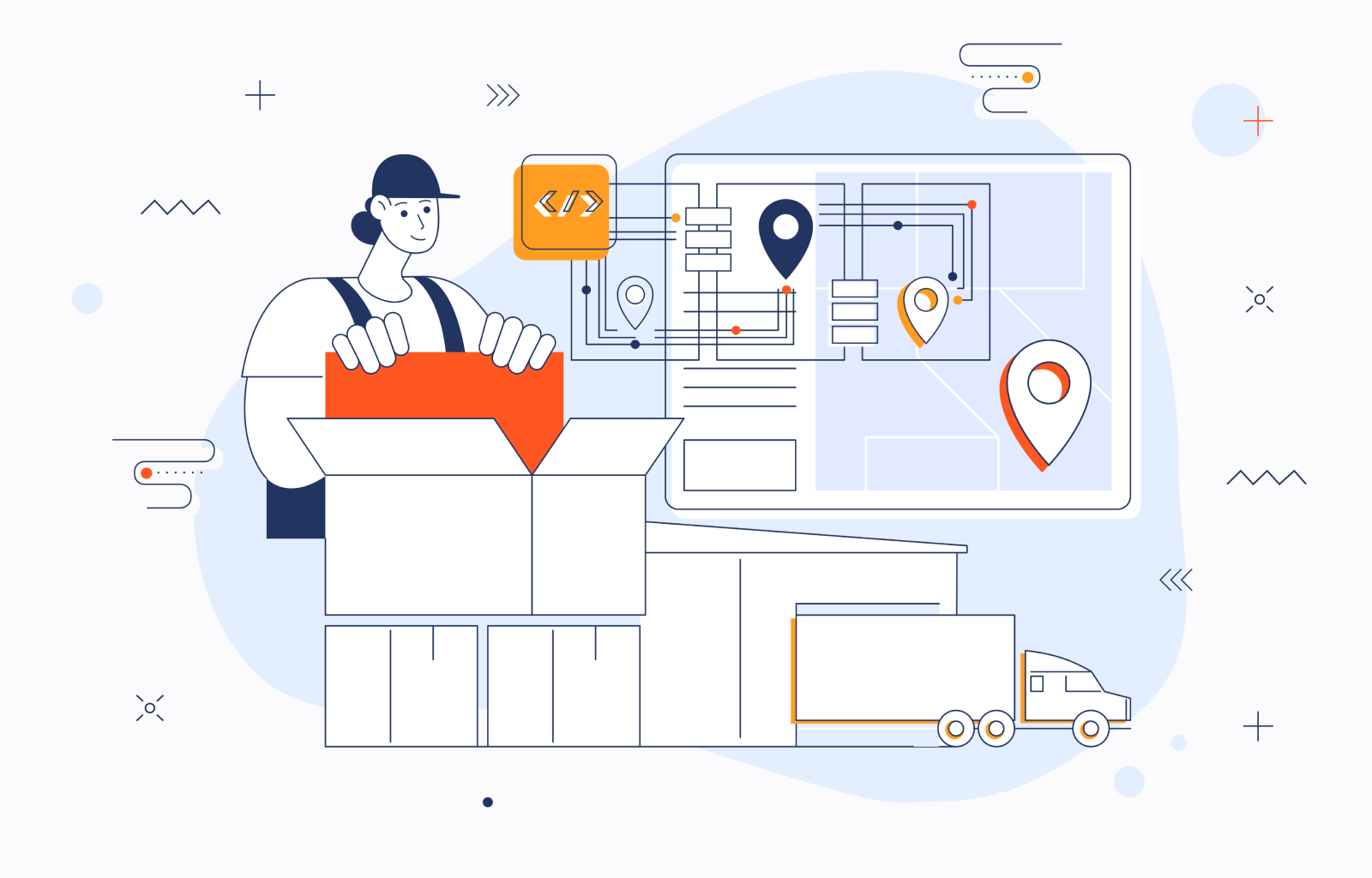How to Develop Demand Forecasting Software for Supply Chain Optimization

6 out of 10 global organizations recognize that geopolitical instability is having a detrimental impact on their supply chains. It makes optimizing the supply chain more important than ever. Striking the right balance between overstocking and running out of products is critical. As a result, demand forecasting is an important aspect of improving supply chain management. It allows companies to handle inventory, reduce costs, identify trends, and anticipate future needs and market changes.
Developing software for demand forecasting is about creating a tool that helps companies transform their supply chains into more agile, cost-effective systems. It also allows their customers to always get what they want when they want it.
In this blog post, we will discuss the main features and requirements to consider when building demand forecasting in supply chains, the main steps of software development, and the required tech stack.
Key Features and Requirements
From pulling in data from all corners of the company to turning it into smart, valuable insights, every part of the demand forecasting software needs to work well together. Whether it is handling massive datasets or offering a clean, intuitive dashboard, the right features should make forecasting feel easy. This gives companies the power to make sharper, faster decisions that drive sales and optimize their processes.
Let's explore the essential features and requirements that form a successful demand forecasting system.
Data Collection and Integration
To establish an accurate supply chain demand forecasting system, the software must integrate with various data sources, such as ERP and POS systems, external market data providers, and others. In addition, it should support multiple data formats like CSV, XML, and JSON while also allowing for API integrations. As a result, it should give the flexibility to gather relevant data from different sources and allow for real-time synchronization and accurate supply chain forecasting.
Data Preprocessing
Accurate forecasting starts with clean data. Data cleaning, normalization, and transformation techniques are essential to preparing raw datasets for analysis. The supply chain demand forecasting software must be smart enough to handle missing values, outliers, and other inconsistencies. This way, the solution works with clean and precise information and returns accurate results.
Forecasting Algorithms
To accommodate different business needs, the software should include various statistical and machine learning models, such as ARIMA, Exponential Smoothing, LSTM, and Random Forest. The real magic comes from being able to mix and match these models, combining them into hybrid approaches helps deliver more accurate predictions. Check out this article for further insights into machine learning applications in logistics and supply chains.
Scalability and Performance
The software needs to be designed for scalability, capable of handling large datasets and real-time data processing without sacrificing performance. Speed is also crucial here — no one wants to wait hours for forecasts when decisions need to be made quickly. Thus, optimization for performance ensures that no matter how big the data for analysis is, the forecasts are accurate and obtained swiftly.
User Interface and Experience
An effective user interface for demand forecasting in supply chain is vital for turning complex data into useful insights. The forecast dashboard should be intuitive and visually engaging, offering charts, graphs, and interactive tools that make the data easy to interpret. To improve user experience, the software should provide customizable reports and alerts. This way, employees can monitor key metrics, adapt to any changes in logistics, and stay a step ahead of demand.
Automation and Customization
Everyone loves automation done right, as tweaking models manually too often is no fun. With automated model training and updates, the software should take care of itself, staying on target.
At the same time, it should allow for customization, enabling you to adjust models, parameters, and forecast periods to match specific business goals. The solution mustn't be one-size-fits-all — businesses should have the opportunity to tailor it to their specific needs.
Security and Compliance
When dealing with sensitive data, security is not just a nice-to-have — it is a must. The software must provide data privacy, secure access controls, and compliance with regulations. Compliance with regulations like GDPR and CCPA is critical to protect customer information and ensure the system operates within legal frameworks. This way, while you’re getting valuable insights, your customers and company data stay protected.
API and Integration Capabilities
Last but not least, the software should provide API endpoints, which make it easier to integrate with other essential systems such as Warehouse Management Systems (WMS) and Transportation Management Systems (TMS). As a result, supply chain demand forecasting software can function as part of a broader ecosystem where every solution works together for efficient operations.
Technology Stack of Demand Forecasting Software for Supply Chain
When developing demand forecasting software for supply chains, the right technology stack is the foundation for success. Every aspect of the tech stack has a role to play in making the software smart and responsive. It should blend creativity and functionality to transform data into clear demand forecasting in supply chain.
While the frontend team focuses on making the forecasting process intuitive and engaging, the backend team employs technologies that ensure everything runs smoothly behind the scenes. Lastly, the technology stack should allow the solution to provide practical insights to boost decision-making and stay agile through fast-paced supply chain processes.
Here are seven types of different technologies you should consider when developing demand forecasting software for supply chain optimization:
Frontend: React.js or Angular for creating dynamic and responsive interfaces.
Backend: Node.js or Python (Django/Flask) for handling data processing and API management.
Database: PostgreSQL or MongoDB for data storage and management.
Machine Learning Frameworks: TensorFlow, Scikit-Learn, or PyTorch for implementing forecasting models.
Data Visualization: D3.js, Plotly, or Chart.js for interactive visualizations.
Cloud Infrastructure: AWS or Google Cloud for hosting, scalability, and data storage.
Version Control: Git/GitHub for collaborative development and version management.
This article covers five major technological trends in supply chain management in 2024, spanning artificial intelligence to robotization. Learn more about the technology in supply chain management in Canada, its potential applications, and its impact on business.
Development Phase of Demand Forecasting Software for Supply Chain
The development phase of demand forecasting software is a critical process that transforms ideas and requirements into a fully functional solution for supply chain optimization. Let's explore the six key steps of development that define the success of the final product.
01.Needs Analysis
The development journey begins with understanding the company — their needs, specific requirements, pain points, and goals for the supply chain demand forecasting software. This step is all about asking the right questions and uncovering the specifics of the company’s supply chain. Understanding the specific demands of industries like transportation and logistics can provide valuable insights. As a result, developers gain knowledge of what kind of software they require and how to tailor it to their unique challenges.
02.Design
Now, it's time for creativity. This step focuses on creating prototypes with a clear understanding of the client's needs. Designers collaborate closely with our clients to outline the user interface (UI) and overall user experience (UX), ensuring that every element is intuitive and user-friendly.
By incorporating all the feedback received, the design process evolves into a clear roadmap for the development team. Wireframes, mockups, and interactive prototypes allow the team to visualize the final product and make adjustments before the coding starts.
03.Development
The development step brings ideas to life, and your customized software starts to take shape. Developers build the frontend and backend components. Throughout this step, collaboration among team members is crucial. They work together to implement features that meet the requirements outlined during the client needs analysis.
04.Testing
The testing step is the quality check that the software functions as intended. This phase is like a rehearsal before the big performance — every component is double-checked. The team of testers runs various scenarios and checks for bugs, ensuring that all demand forecasting methods in supply chain function well and deliver accurate predictions. This step requires meticulous attention to detail. So when the software goes live, it can hit the ground running.
05.Deployment
After successful testing, the software is ready for deployment — making software available to end-users. This step sounds easy, however, it requires careful planning, coordination, and training sessions that can help your team navigate it.
The deployment process often includes creating a detailed launch plan that outlines timelines, resource allocation, and risk management strategies. The goal is to make the transition as smooth as possible, so supply chain demand forecasting works as accurately as the clock. But once we're finished here, you are ready to start with the demand predictions.
06.Maintenance and Updates
Ongoing maintenance and updates are crucial for long-term success. Regular improvements ensure the software continues to perform at its best, adapting to the market trends and providing valuable insights. This phase involves monitoring the software's performance, identifying any issues, enhancing functionality, or addressing changing business needs. Our team will gladly help you make sure the demand forecasting tool we developed functions as clockwork.
Make a strategic investment in your business's future
As global supply chains face more and more uncertainties, the ability to accurately predict demand becomes a critical advantage. Demand forecasting software for supply chain optimization empowers businesses to navigate supply challenges, stay agile, and keep their customers satisfied by delivering the right products at the right time.
Our team is ready to help you develop a solution that will perfectly suit your business's needs. It's a strategic investment that will certainly reward you in the long run. Contact us to learn more.
Contact us

